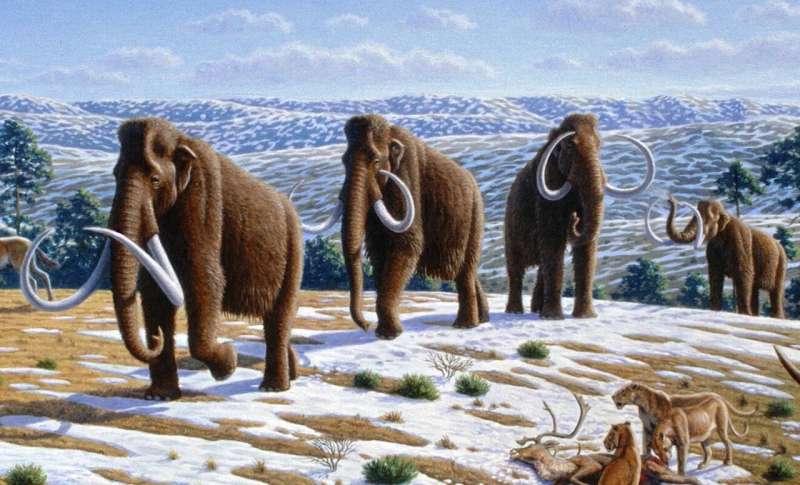As carbon dioxide accumulates in the atmosphere, the Earth will get hotter. But exactly how much warming will result from a certain increase in CO2 is under study. The relationship between CO2 and warming, known as climate sensitivity, determines what future we should expect as CO2 levels continue to climb.
New research led by the University of Washington analyzes the most recent ice age, when a large swath of North America was covered in ice, to better understand the relationship between CO2 and global temperature. It finds that while most future warming estimates remain unchanged, the absolute worst-case scenario is unlikely.
The open-access study was published April 17 in Science Advances.
“The main contribution from our study is narrowing the estimate of climate sensitivity, improving our ability to make future warming projections,” said lead author Vince Cooper, a UW doctoral student in atmospheric sciences. “By looking at how much colder Earth was in the ancient past with lower levels of greenhouse gases, we can estimate how much warmer the current climate will get with higher levels of greenhouse gases.”
The new paper doesn’t change the best-case warming scenario from doubling CO2—about 2 degrees Celsius average temperature increase worldwide—or the most likely estimate, which is about 3 degrees Celsius. But it reduces the worst-case scenario for doubling of CO2 by a full degree, from 5 degrees Celsius to 4 degrees Celsius. (For reference, CO2 is currently at 425 ppm, or about 1.5 times preindustrial levels, and unless emissions drop is headed toward double preindustrial levels before the end of this century.)
As our planet heads toward a doubling of CO2, the authors caution that the recent decades are not a good predictor of the future under global warming. Shorter-term climate cycles and atmospheric pollution’s effects are just some reasons that recent trends can’t reliably predict the rest of this century.
“The spatial pattern of global warming in the most recent 40 years doesn’t look like the long-term pattern we expect in the future—the recent past is a bad analog for future global warming,” said senior author Kyle Armour, a UW associate professor of atmospheric sciences and of oceanography.

This artist’s rendition shows woolly mammoths in northern Spain. These animals lived in Europe and North America during the last glacial period, around 21,000 years ago. A new study used updated climate maps from that period, when atmospheric carbon dioxide was lower, to better predict future warming under rising CO2. © Mauricio Anton, Wikimedia, CC BY 4.0
Instead, the new study focused on a period 21,000 years ago, known as the Last Glacial Maximum, when Earth was on average 6 degrees Celsius cooler than today. Ice core records show that atmospheric CO2 then was less than half of today’s levels, at about 190 parts per million.
“The paleoclimate record includes long periods that were on average much warmer or colder than the current climate, and we know that there were big climate forcings from ice sheets and greenhouse gases during those periods,” Cooper said. “If we know roughly what the past temperature changes were and what caused them, then we know what to expect in the future.”
Researchers including co-author Gregory Hakim, a UW professor of atmospheric sciences, have created new statistical modeling techniques that allow paleoclimate records to be assimilated into computer models of Earth’s climate, similar to today’s weather forecasting models. The result is more realistic temperature maps from previous millennia.
For the new study the authors combined prehistoric climate records—including ocean sediments, ice cores, and preserved pollen—with computer models of Earth’s climate to simulate the weather of the Last Glacial Maximum. When much of North America was covered with ice, the ice sheet didn’t just cool the planet by reflecting summer sunlight off the continents, as previous studies had considered.
By altering wind patterns and ocean currents, the ice sheet also caused the northern Pacific and Atlantic oceans to become especially cold and cloudy. Analysis in the new study shows that these cloud changes over the oceans compounded the glacier’s global cooling effects by reflecting even more sunlight.
In short, the study shows that CO2 played a smaller role in setting ice age temperatures than previously estimated. The flipside is that the most dire predictions for warming from rising CO2 are less likely over coming decades.
“This paper allows us to produce more confident predictions because it really brings down the upper end of future warming, and says that the most extreme scenario is less likely,” Armour said. “It doesn’t really change the lower end, or the average estimate, which remain consistent with all the other lines of evidence.”
More information:
Vincent Cooper et al, Last Glacial Maximum pattern effects reduce climate sensitivity estimates, Science Advances (2024). DOI: 10.1126/sciadv.adk9461. www.science.org/doi/10.1126/sciadv.adk9461
Provided by
University of Washington
Citation:
Ice age climate analysis reduces worst-case warming expected from rising CO₂ (2024, April 17)



